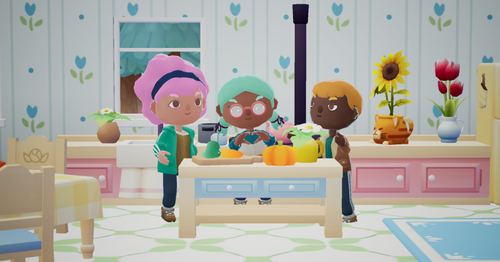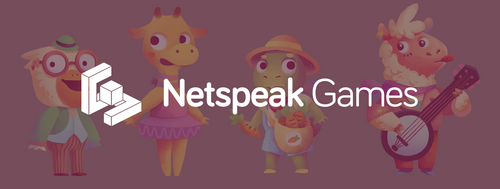Finding Our Audience
Ed Sibley

A few weeks ago, the Guardian published a depressing but unsurprising article about how half of British female gamers experience abuse when playing online games.
Our aim at Netspeak is to create safe online spaces that are explicitly welcoming to people from marginalized and underrepresented backgrounds, and so this naturally resonated with us and we felt compelled to tweet our feelings on the subject - but that only really touches the surface of an issue which we, as a studio, regard as far more complex. This post describes our approach to understanding the needs of our audience and how that process informs what Sunshine Days is.
Audience Needs
The main audience for our game is, perhaps unsurprisingly, women aged 18-35. Women have, historically, been neglected as a market for games, and those games that have been aimed at women have often seemed to shrug and say “games for women are about looking cute and wearing makeup”. Although things are improving, it’s still very much the case that many games aimed at women take a narrow, simplistic view of the needs of their audience, which inevitably leads to poor games which fail commercially - a self-fulfilling prophecy.
One way we’re trying to break the cycle is by building a well-balanced development team where important decisions are made by people who actually have something in common with the audience - something Katharine posted about last week. But another, equally important element of our strategy is to make sure our work is built on a strong understanding of who our audience actually are, and what they actually need from their games.
Research and Data
Since the earliest days of the studio, Netspeak has had dedicated player researchers and data scientists on the team, whose role is to produce insights into the game and our players which can guide development. We have all sorts of tools at our disposal here, including:
- Player Interviews - Directly interviewing members of our target audience, either about their general tastes and preferences in games, or about their experiences in Sunshine Days
- Concept Tests - Showcasing concept art to get early feedback and preferences on character designs, world designs, Season Pass themes and much more
- Playests - Sending builds of the game to playtesting companies to get specific, detailed insights about new features and mechanics
- Reporting - Reviewing the performance of adverts and features once they’re released to see if players are responding to them in the way we hope they will
- Asking The Discord - Our discord community is an incredibly cheerful, positive space and we frequently drop in to get temperature-checks and reactions to upcoming content, as well as reviewing their suggestions for the game every week
For our UX team, understanding the audience is a full-time job and a responsibility we take very seriously.
Plurality
One point that sounds obvious but which often bears repeating is that “women aged 18-35” describes the boundaries of our audience, but it does not imply that everyone in that massive, varied group has the same tastes and needs and preferences. Demographics are bullshit, really. Take any two people of the same age, same gender identity, same upbringing, same school even, and they’re not even going to be watching the same Netflix shows. By the same token, the needs of our audience are far more plural than the industry seems to think. Some want stress-free cozy games, while others enjoy high-skill competitive games. Some want complex problems to solve, and some want interesting worlds and stories to lose themselves in. In our view, part of the reason why hostility to women is so endemic in online gaming is because the industry typically presents “complex games” as being “games for men” - an association which many men have now internalized and feel entitled to, despite it being entirely untrue.
We must also acknowledge that the audience’s needs change as people get older and their personal circumstances shift. Our feeling at Netspeak is that this element of the narrative was missing from the study referred to in the Guardian article. One example from our own research is to do with the amount of time available for gaming. Players at the younger end of the spectrum are just starting to have the economic means and the time to invest in heavy gaming activities, whereas older members of the audience have many more demands on their time, with greater work and family responsibilities, which have a much greater impact on women than they do on men. This means that they have less space in their life for hardcore games, despite still basically enjoying them.
Accessibility
One respect in which games can fail to meet their audience needs is by failing in accessibility - and again, it’s often the case that our audiences’ needs are overlooked in this area. One recent interviewee mentioned that she wished our game used the sort of tap-to-move control scheme you see in other 3D mobile titles, so she could play with one hand - and when we asked why, she told our researcher that it’s because she spends a lot of time holding a baby, and so she prefers games you can play with one hand (we’re currently prototyping a tap-to-move control scheme of our own in response to this).
Finding ways to balance this plurality of needs and produce a game which everyone is able to enjoy is something we take very seriously, and when you really settle into this way of thinking, you start thinking differently about all kinds of design and product choices. As an example, here’s a dilemma we’re currently struggling with - at the moment, you can only place 1000 items in your Sunshine Days house. When we first implemented this limit, we set the number at 1000 because we thought it was much higher than any player was likely to hit. However, recently, lots of players in our Discord community have been asking us to raise it because they’re hitting it (which, by itself, is really cool!)
However, when we test versions of the game with significantly higher limits, we find that the game becomes virtually unplayable on lower-end devices. It would seem, then, that we have to compromise one side of our audience or the other - we’re either failing our most committed players who want to build impressive stuff in the game, or we’re failing younger players or players from less well-off backgrounds who typically don’t play on high-end devices. The onus is on us to find a smart solution which works for everyone. We’re not sure what that solution is yet but we’re confident we’ll figure it out.
Our Philosophy
Overall, our position on the current state of the market is this. Firstly, the industry (us included) needs to recognise that the global audience for games is more varied than they think. Many women are excluded from enjoying games not because they don’t want to play games, but rather because those games fail to accommodate them - either by being outright hostile, or by failing them in more nuanced ways.
Secondly, companies that make games for women need to stop thinking it's just about rainbows and ribbons. You have to think deeply about the people you're making the game for, and not reduce them to a set of tired old stereotypes. Make it cute, by all means, but don't mistake that for substance.

